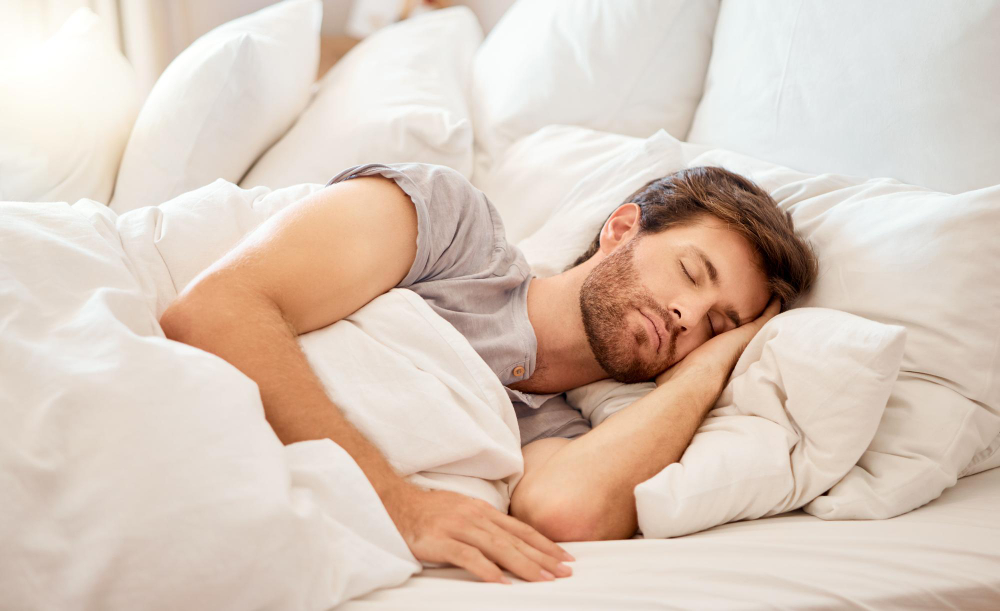Article
The Evolution of Sleep Ergonomics: How Pillows Have Changed Over Time
Imagine snuggling into your bed after a long day, your head gently cradled by a pillow that feels like it was made just for you. This isn't just about luxury; it's about how the right sleep setup, especially your pillow, can be a game-changer for your health and well-being.

That's where sleep ergonomics comes into play—ensuring your nighttime posture aligns perfectly with your body's needs. It's a science that blends comfort with anatomy, and it's been evolving quietly behind the scenes of history to give us the rest we deserve.
In this exploration, we'll delve into the transformation of pillows, from ancient stone to the latest in memory foam technology, and we will uncover why optimizing your sleep isn't just a modern-day indulgence—it's a timeless pursuit of well-being.
The Ancient Roots of Sleep Supports
Tracing back to ancient civilizations, we find that our ancestors were already on the quest for restful slumber.
The earliest pillows were far from the plush cushions we know today. In ancient Mesopotamia, they were made of stone and often had a slightly curved design to cradle the neck.
The Egyptians, valuing the head as the seat of life, crafted their headrests from wood or stone, not just for comfort but also to protect the sleeper from ground crawlers.
In ancient China, ceramics and bamboo were fashioned into pillows, believed to provide health benefits and keep demons at bay. These materials, hard to the modern touch, were chosen for durability and coolness, reflecting the intricate balance between environment, belief, and the human body.
This initial chapter in the history of sleep support shows a fascinating intersection of practicality and spirituality, laying the foundation for the evolving understanding of sleep ergonomics.
The Middle Ages to the Renaissance: The Evolution of Comfort
As humanity progressed into the Middle Ages and Renaissance, the evolution of pillows mirrored the social and cultural transformation of the times. The stark, rigid designs of the ancients gave way to softer, more yielding materials.
People began to fill pillow covers with straw, reeds, or feathers, depending on their social status and local customs. The nobility often favored down feathers for their softness and warmth, a luxury that symbolized status as much as it provided comfort. This period was marked by a blossoming of art and science, and with that, an increased attention to human comfort and the body's needs during sleep.
Pillows became more than just a place to rest one's head; they were recognized as a means to support the natural curvature of the neck and spine.
The introduction of new stuffing materials like wool, cotton, and down feathers during this time reflects a growing appreciation for comfort, a sentiment that would eventually lead to our modern understanding of ergonomics in sleep.
The Industrial Revolution: Mass Production and Standardization
The advent of the Industrial Revolution brought a seismic shift to the production and availability of pillows. Mass production techniques emerged, transforming pillows from handcrafted items to widely available commodities.
The introduction of new machinery allowed for the standardization of pillow sizes and fills, making them more uniform and accessible to the general public. This era of industrialization also saw the introduction of man-made stuffing materials, such as synthetic fibers, which provided to be a hypoallergenic and affordable alternative to traditional down feathers.
The assembly line mentality applied to pillow manufacturing mirrored the larger societal shift towards efficiency and uniformity, setting the stage for future innovations in the design and production of sleep support that aimed to meet the needs of the masses.
The 20th Century: The Dawn of Health Consciousness
The 20th century heralded a new era in the world of sleep ergonomics, one where the spotlight turned to health and well-being.
As medical science advanced, so did the understanding of the body's needs during rest. This was the dawn of health-conscious pillow designs, with a focus on spinal alignment and prevention of sleep-related disorders. Ergonomic pillows, contoured to support the natural curve of the neck and back, started to emerge. These designs were driven by a growing awareness that proper alignment could enhance blood flow, reduce muscle tension, and improve overall sleep quality.
Pillows were no longer mere soft places to rest but became tools of wellness, intricately designed to cater to the complexities of the human form. This health-centric approach marked a significant shift in the perception and importance of pillows in achieving a holistic, restorative sleep experience.
The Rise of Modern Materials: Memory Foam and Beyond
With the latter half of the 20th century came a groundbreaking innovation in sleep technology: memory foam. Developed by NASA in the 1960s for spacecraft cushions, this material soon revolutionized the world of sleep ergonomics. Memory foam's viscoelastic properties allowed it to contour precisely to the body's shape, offering unparalleled support and comfort. This adaptation meant that for the first time, a pillow could distribute weight evenly, reduce pressure points, and maintain spinal alignment throughout the night.
As memory foam pillows entered the market, they set a new standard for what a pillow could offer. They were no longer just passive objects but active participants in sleep health. The impact was significant: people began to report reduced neck and back pain, and the material's hypoallergenic properties also appealed to health-conscious consumers.
The surge in popularity of memory foam spurred further innovation, leading to the development of cooling gels and hybrid materials, which offered additional benefits such as temperature regulation. The rise of modern materials in pillow manufacturing marked a pivotal moment, where the quest for the perfect night's sleep became a tailored experience, responsive to the individual needs of the sleeper.
Understanding Modern Sleep Ergonomics
Modern sleep ergonomics is rooted in the principle of aligning sleep practices and environments with the body's physiological needs.
Professionals in the field emphasize the importance of a sleep setup that maintains the natural curve of the spine and supports the body in a neutral position. This holistic approach extends beyond just the choice of a pillow or mattress; it encompasses the entire sleep environment, including the arrangement of bedding and the ambient conditions of the sleep space.
Ergonomic sleep solutions are designed with a deep understanding of anatomy and sleep science, aiming to enhance the quality of rest and, by extension, the quality of life.
As sleep ergonomics continues to evolve, it promises more innovative designs and personalized options, underscoring the belief that a well-rested world is a healthier, happier one.
The Scrumptious Side Pillow: A Case Study in Innovation
The Scrumptious Side Pillow stands as a testament to the ingenuity of Honeydew Sleep, a family-owned business with a clear mission: to revolutionize the way we rest. Born from a dissatisfaction with mainstream pillow options and a drive to create a bespoke sleep experience, the Scrumptious Side Pillow is their flagship creation, embodying years of research and passion. Designed and handcrafted in Southern California, this pillow is more than a resting place for the head—it's an innovation in personalized comfort.
Its distinctive gentle curve is not just a design choice but a functional feature that supports the neck and shoulders, making it ideal for side, back, or stomach sleepers. This versatility shatters the one-size-fits-all approach, acknowledging the unique preferences of each individual. Honeydew Sleep's commitment to customization is further exemplified by the adjustable nature of their pillows, allowing users to find their perfect fit for a truly tailored sleep experience.
The materials used are of the highest caliber, with CertiPUR-US certified, copper-infused foam crafted locally. The proprietary fill—a secret blend described as 'doughy' yet supportive, cooling, and hypoallergenic—is the result of years of refinement, offering a distinctive feel that sets the Scrumptious Side Pillow apart from its contemporaries. Honeydew's dedication to quality and customer satisfaction has not only led to a product that changes lives but has also forged a strong community of devoted users, driving the brand's growth organically. This pillow is not just a sleeping accessory; it's a sleep solution that encapsulates the ethos of Honeydew Sleep—improving the world, one night at a time.
The Science of Sleep: How Ergonomics Improves Rest
Scientific research underscores the profound impact of ergonomic design on sleep quality. Studies consistently reveal that proper head and neck support, provided by ergonomically designed pillows like the Scrumptious Side Sleeper Pillow, can significantly enhance sleep.
Ergonomic pillows contribute to maintaining spinal alignment, which is crucial in preventing musculoskeletal pain and discomfort. This alignment supports the natural curvature of the spine, promoting a more therapeutic sleep posture that facilitates muscle relaxation and reduces tossing and turning. The result is a deeper, more restorative sleep, as the body is better able to undergo its natural repair processes during the night.
The science of sleep ergonomics thus serves as a bridge connecting the design of our sleep accessories to the overarching goal of achieving optimal health and well-being through rest.
Looking Ahead: The Future of Sleep Ergonomics
The future of sleep ergonomics shines bright with potential, promising innovations that further personalize rest.
Advancements in smart technology may lead to pillows that can adjust their shape in real time, responding to the sleeper's movements and sleep stages for optimal alignment.
Materials science will likely unveil will be new sustainable fills that regulate temperature and improve breathability, enhancing comfort while being kind to the planet. We might also see a leap in biometric integration, with pillows monitoring vital signs to not only improve sleep but also track health metrics.
Furthermore, the integration of AI could offer sleep analysis, providing personalized recommendations for sleep improvement.
As we move forward, the potential for pillows to not only improve sleep but also to serve as critical tools for health monitoring and lifestyle adjustments becomes ever more apparent, reflecting a future where technology and well-being are seamlessly intertwined.
Restful Horizons: Seizing the Legacy of Sleep Innovation
From the stone and wood supports of ancient times to the latest in adjustable, memory foam innovation, the evolution of sleep ergonomics reflects our relentless pursuit of the perfect night's sleep. The journey has been long, winding through eras that introduced softer materials, health-conscious designs, and modern, smart technology. Today, we stand on the cusp of a new dawn, where sleep accessories are not merely about comfort but are pivotal to our overall health and well-being.
Take a moment to consider your own sleep ergonomics. Are you giving your body the support it needs to rejuvenate each night? Reflect on the quality of rest you're receiving and remember that the right pillow can be a simple, yet profound, step towards a healthier life. We encourage you to explore the advancements in sleep ergonomics and take that step towards transforming your sleep, and in turn, transforming your life.
Frequently Asked Questions (FAQ)
Q: What is sleep ergonomics, and why is it important?
A: Sleep ergonomics is the study and design of sleep environments to fit a person's physical needs and to improve the quality of sleep. Proper sleep ergonomics can help maintain spinal alignment, prevent pain, and ensure deep, restful sleep.
Q: How do pillow materials affect sleep quality?
A: The materials used in pillows can impact breathability, support, and comfort. Natural materials like down feathers are soft and insulating, while modern memory foams provide contoured support and can include cooling technologies to regulate temperature.
Q: Can the right pillow really improve my sleep?
A: Absolutely. The right pillow can significantly improve your sleep by ensuring proper neck alignment and support, which reduces the likelihood of waking up with stiffness or pain, leading to better overall sleep quality.
Q: What makes the Scrumptious Side Pillow different from other ergonomic pillows?
A: The Scrumptious Side Pillow by Honeydew Sleep stands out with its unique curve that supports sleepers in all positions. It's adjustable, allowing for personalized height and firmness, and uses high-quality, hypoallergenic materials that cater to both comfort and health.
Q: Are there any specific benefits of the Scrumptious Side Pillow for neck pain?
A: Yes, the Scrumptious Side Pillow is designed to provide optimal support for the neck, reducing stress on the cervical spine. Its adjustable nature allows users to find the perfect loft and firmness to alleviate neck pain.
Q: Is the Scrumptious Side Pillow suitable for all sleep positions?
A: Yes, its design supports side, back, and stomach sleepers. The adjustable fill ensures that sleepers of all positions can achieve proper alignment and comfort.
Q: Where can I purchase the Scrumptious Side Pillow?
A: The Scrumptious Side Pillow is available for purchase on the Honeydew Sleep website and may be available at select retailers. Be sure to purchase through official channels to ensure authenticity and to receive the full benefits of the 60-night risk-free trial.
* In partnership with our friends at Honeydew Sleep* Photo courtesy of Honeydew Sleep*
* These statements have not been evaluated by the Food and Drug Administration. These products are not intended to diagnose, treat, cure or prevent any disease.
* The information available on ewellnessmag.com, including text, graphics, and other materials is for informational purposes only. Reliance on any information in ewellnessmag.com is at the user's own risk. Sponsored product placement may appear in the article. The visitor of this website acknowledges that the information available on or through ewellnessmag.com is not and is not intended to be a substitute for professional medical advice. Copyright © 2023 Brawo Press, Inc. All rights reserved.
Share article











You must be logged in to add a comment ... → Log in | Register